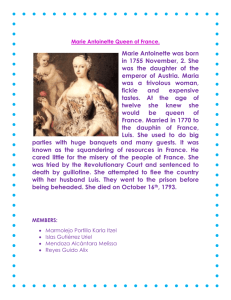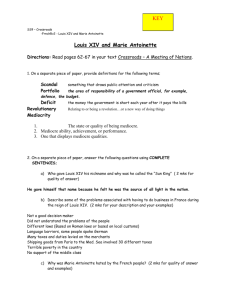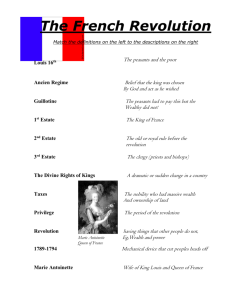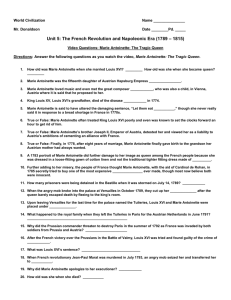SCRATCHING AT THE SURFACE
advertisement
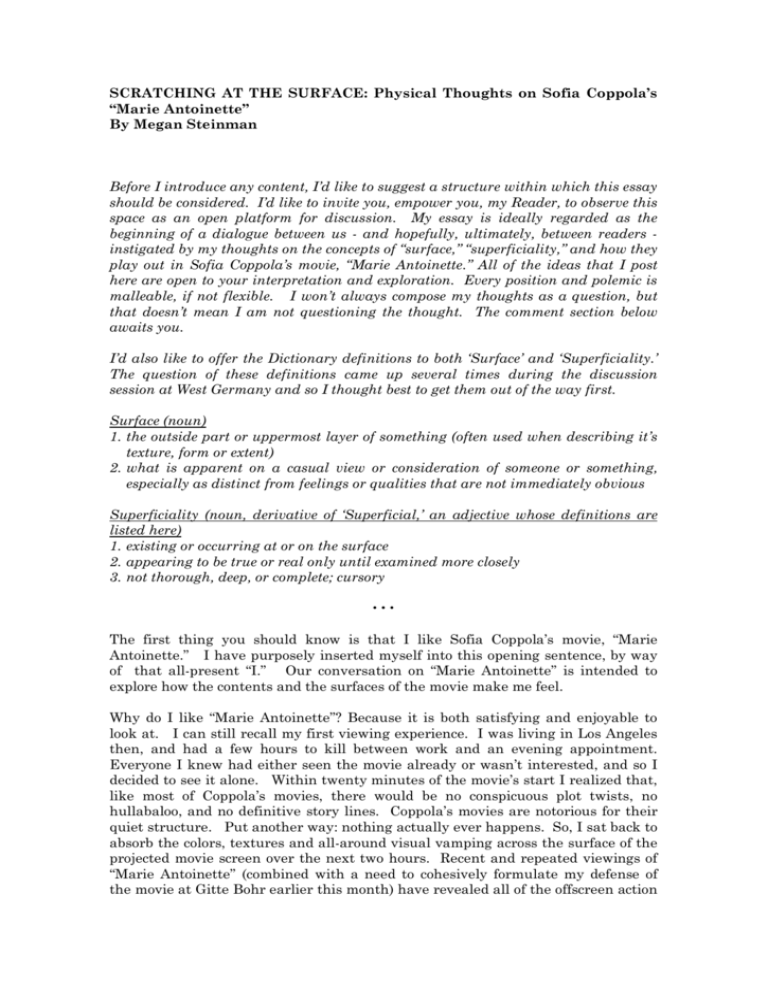
SCRATCHING AT THE SURFACE: Physical Thoughts on Sofia Coppola’s “Marie Antoinette” By Megan Steinman Before I introduce any content, I’d like to suggest a structure within which this essay should be considered. I’d like to invite you, empower you, my Reader, to observe this space as an open platform for discussion. My essay is ideally regarded as the beginning of a dialogue between us - and hopefully, ultimately, between readers instigated by my thoughts on the concepts of “surface,” “superficiality,” and how they play out in Sofia Coppola’s movie, “Marie Antoinette.” All of the ideas that I post here are open to your interpretation and exploration. Every position and polemic is malleable, if not flexible. I won’t always compose my thoughts as a question, but that doesn’t mean I am not questioning the thought. The comment section below awaits you. I’d also like to offer the Dictionary definitions to both ‘Surface’ and ‘Superficiality.’ The question of these definitions came up several times during the discussion session at West Germany and so I thought best to get them out of the way first. Surface (noun) 1. the outside part or uppermost layer of something (often used when describing it’s texture, form or extent) 2. what is apparent on a casual view or consideration of someone or something, especially as distinct from feelings or qualities that are not immediately obvious Superficiality (noun, derivative of ‘Superficial,’ an adjective whose definitions are listed here) 1. existing or occurring at or on the surface 2. appearing to be true or real only until examined more closely 3. not thorough, deep, or complete; cursory ••• The first thing you should know is that I like Sofia Coppola’s movie, “Marie Antoinette.” I have purposely inserted myself into this opening sentence, by way of that all-present “I.” Our conversation on “Marie Antoinette” is intended to explore how the contents and the surfaces of the movie make me feel. Why do I like “Marie Antoinette”? Because it is both satisfying and enjoyable to look at. I can still recall my first viewing experience. I was living in Los Angeles then, and had a few hours to kill between work and an evening appointment. Everyone I knew had either seen the movie already or wasn’t interested, and so I decided to see it alone. Within twenty minutes of the movie’s start I realized that, like most of Coppola’s movies, there would be no conspicuous plot twists, no hullabaloo, and no definitive story lines. Coppola’s movies are notorious for their quiet structure. Put another way: nothing actually ever happens. So, I sat back to absorb the colors, textures and all-around visual vamping across the surface of the projected movie screen over the next two hours. Recent and repeated viewings of “Marie Antoinette” (combined with a need to cohesively formulate my defense of the movie at Gitte Bohr earlier this month) have revealed all of the offscreen action that I, too, initially overlooked, but which provide interesting provocations and potential tools for dismantling Superficiality. Surfaces and their spatial representations surround us. In many ways, every individual acts as a surface: our bodies operate as interfaces between us and the world. “Scratching at the Surface” refers to a daily process during which we intake, evaluate and output a complex series of gestures influenced by, and which influence, our external cultural and internal dispositions. As of late, however, the body as operator of this system, is repeatedly denied. Examples of this are everywhere. Men and women are dying in wars throughout the world, but their lifeless bodies are never seen and therefore disregarded. They are transformed from person to statistic.1 In the United States, recent congressional hearings meant to decide upon the reproductive rights of women meet without a single female body present. Our ‘Social Media Made Selves’ are composed of data that describes where we go, the Mayors of those locations, what we “Like,” what we’ve FFFound, what are our Pinterests, who we are with, and when. Maybe “It’s Complicated” because all that data can’t wrap its arms around us at night. What I’d like to explore here is how an active role of viewership might get us beyond - or below - the surface. I want to return to the words “satisfying” and “enjoyable” - because they tether the critique to the critic (i.e. me). If we begin by acknowledging ourselves and our dual roles as both receivers and interpreters, then we are also acknowledging an active thought process that defines our spatial relationship to various surfaces. From this position we can begin to deconstruct and decide how to navigate - the information we encounter on these surfaces. Coppola uses a series of formal visual aspects to activate her viewers and the surface of her film as a place to connect herself both to her viewers and to Marie Antoinette's historical biography. How do we arrange ourselves in relation to history? Should we consume historical facts and figures, accept them as truth and move on? Or should we find a way to relate ourselves to the situations that historical figures found themselves in, thereby suggesting a commonly held notion that every story has infinite versions depending on the storyteller. There is no correct answer here, of course. Only personal directives, especially when it comes to making artistic decisions. For the construction of “Marie Antoinette,” Coppola selected the second option. She inserts herself and her own personal references into the both the imagery and audio of her movie. The soundtrack, the converse sneakers that famously make an appearance arranged on the floor next to a mess of period shoes and props, an appearance by the rock band, Phoenix, all feel uniquely and unequivocally “Sofia.” These decisions serve two purposes. First, they create a conscious dialogue between the director and the viewer. A cheeky nod that says she knows that we know she knows we are watching. But are we watching and listening and processing closely? Second, these elements interrupt the illusion of any specific historical time and thus alert us to a) the fact that we are watching, and b) that what we are watching is as much fiction as it is “based” on historical events. There are two visual tropes that Coppola repeats throughout the movie. One might also argue this transformation from person to statistic occurs when a soldier enlists in the armed forces of their respective country. 1 The first, are a series of nearly symmetrical compositions that invoke both classic perspective paintings and stage sets. Similar to their source material, these images are full of visual codes that active audiences must decipher. In the same way that we would stand in front of the surface of a 2D painting, studying its compositional factors that the painter has selected, the scenography of these compositions allows us to drop below the surface textures of the image (the tapestries, the taffeta, the colors, animals, feathers and more) and understand the significance of these symbols and what their presentation to us can generate. The fact that there are (at least) two of every element contained in these sets, indicated by their symmetrical composition, is our first visual cue of the opulence of, and over-indulgence in, material goods by France’s royal court. Many of the symmetrical scenes occur during meals. Viewers are provided a privileged seat at the royal dining table with a view that displays pyramids of shrimp butterflied to perfection, colorful towers of asparagus, artichokes and mushrooms, bushels of parsley sprigs placed just so, lobsters positioned as if in conversation and bread baked in the shape of dueling dragons. And yet, among all of these delights sits the royal couple surrounded by attendees and courtesan voyeurs as if attending at their perpetual last supper. One of the last symmetrical scenes features Marie Antoinette bowing to an angry mob of French citizens that have stormed the gates of Versailles. The image is immediately relatable to Caravaggio’s masterpiece, “Narcissus.” Coppola’s dominant black background and foreground of candle (or fire) lit whites and yellows mimics the painterly style of Caravaggio’s era. Perhaps if the movie was understood as a durational painting the expectations of its content would also be altered. We do not wait for a painting to speak to us and reveal its coded information. We must actively participate in the translation process, combining our individual histories, understanding of particular visual cues and the contexts within which the painting was created and is viewed. The surface of a painting can become a place that we go to connect with our own comprehension of historical fact. Coppola has adopted this process, from which we must connect codes and our own understanding of historical events in order to read her film. If we work to align the pace of our viewership with - or at the very least acknowledge - Coppola’s quiet, meditative directorial style, and are patient with her surface delivery system, then there is much to discern about what lies beneath the onscreen action and what that means to the viewer. Such demonstrations of wealth and waste within our contemporary context are surely an impetus for discussions on Surface and Superficiality that we are having today. Coppola contributes to the conversation via pictures and sounds rather than words. Historically this tactic has been utilized to invite the most amount of viewers, regardless of literacy or language skills, into political discussions. The film’s soundtrack is a collection of new wave songs with lyrics that narrate the onscreen action. The very first words we hear in the film are the band, Gang of Four, singing, “The problem of leisure, what to do for pleasure.” This question is then figuratively and formally explored for the duration of the film. You could slip a critique in here that these lyrics are there to “help” the viewer decipher the onscreen content mostly devoid of dialogue. But perhaps that is best left for another discussion. (or… comment as you wish below!) That same Gang of Four song later repeats, “Repackaged sex keeps your interest.” “Repacked Sex” brings me to the second visual trope seen throughout the movie: a cakewalk (pun completely intended) of visual and visceral pleasures that reaches its scenographic apex in an approximately five minute montage of rapid edit cuts set to the Bow Wow Wow’s classic, “I Want Candy.” Awash in many nuanced shades of pink, turquoise, yellow and lavender that I had no idea existed prior, this imagery is so coquettish and supple as to give the viewer the tangible experience of the pleasure onscreen. Wide-mouthed and shallow crystal champagne glasses are filmed from a perspective to generate a sensation of their interior liquids pouring down our throats. Atop other flutes the foamy effervescence bubbles over rims in the shape of erect nipples. We are offered a God-like vantage point to observe - and perhaps judge - meticulously designed cake creations. The sponginess of every pastry gets both a caress and squeeze before being inserted into the mouths of feisty and apparently ravenous French Courtesans, their cream centers bursting in all directions with each bite. In another scene, set in the serenity of Marie Antoinette’s manufactured countryside, she cradles a baby lamb, her breasts falling out over the top of her linen frock in a bestial offering of mother’s milk to the young animal. It should also be noted that in this moment the frame ominously beheads the Queen. These images all crafted like the juiciest romance novel. There are several moments that directly acknowledge and engage the viewer/voyeur. I counted three times that Marie Antoinette, draped wistfully over velvet chaise lounges, looks directly into the camera with eyebrows raised in a come-hither look meant to drag us from our seats into the on-screen action. The swaths and swatches of pink satin and taffeta that surround her solidify their likely intended Lolita affect. I’d like to suggest that sensuality and the acknowledgement of pure bodily pleasures might be a tool to combat superficiality. It gives a visceral depth to experience and reminds of us of the importance of physically-based social relations and emotional connection. In “Marie Antoinette,” sensuality is represented by an endless satiating of wanton desires with food, fashion, gambling, theatre, and more. This is not meant to imply that I condone a life purely based on the selfish pleasuring of ones body. Selfless participation in ones extended community and collective social responsibility within our respective environments are essential for the health of our individual psyches and for the health of this planet we all share. Thus, the decadence of the French Court must be considered within the specific context in which it occurred. The royal family’s life at Versailles operated under strictly coded performances of pomp and circumstance that bore zero resemblance to the lives of the average French citizen. The cost of these performances were both financial, accelerating France’s then-bankruptcy, and psychological, producing the deep rift between the monarchy and its subjects that would ultimately lead to its downfall. Duly noted, I'd like to return to the movie and my suggestion that there is nothing superficial about the psychological pleasures derived from the immediate satiation of specific sensual desires we are so often taught to negate in favor of work, family and social politics. Historically, sensual pleasures (or rather, pleasuring) were actually core functions of Marie Antoinette's work, family and social politics. Her life existed primarily to produce offspring that would become heirs to the French throne and maintain the precariously peaceful alliance between France and Austria. Thus, the movie spends a majority of its time portraying what can best be described as a teenager trying to negotiate her first sexual encounter with a husband she barely knows and who is uninterested in her will. Coppola's Marie Antoinette creates a concept (not “the concept,” just “a concept”) of ideal femininity through fashion- and spatially-designed fantasies throughout Versailles and Paris. This concept becomes her tool of seduction in an attempt for real connection with her husband. So again - we have two core surfaces to contend with: 1. we are positioned in front of a static painting meant to invoke history and the theatre of the French royal court. 2. in which all bodily pleasures collide with one another: through food, debauchery, sex, sensuality. The traveling between two surfaces is where the majority of the movie spends its time. In order to dig a little deeper below the surfaces of Coppola’s film, I thought I would include a short comparison of its visuals and storytelling techniques with David Grubin's PBS documentary, "Marie Antoinette: The Last Queen of France." Grubin’s film is a historical reconstruction of Marie Antoinette’s life composed through a series of event re-enactments with fictional actors, filmed paintings, scholarly interviews and slightly dramatic narrations common to the documentary genre. In my opinion, his selected imagery is considerably less visually appealing. Grubin also uses music that is historically inaccurate. His construction technique is useful, easy to follow and informative, but ultimately formulaic. Interestingly enough, the documentary's factual content reveals that Coppola's film was quite accurate in its portrayal of a Queen completely removed from society. For example, we learn that Marie Antoinette never saw the ocean in her entire life. And in an interview, one of the historians refers to Marie Antoinette as a “bumbling teenager hanging out with her friends.”2 If Coppola’s facts are essentially in order, the question then becomes: why is her film criticized so heavily while the Grubin’s documentary is lauded as a compelling investigation of Marie Antoinette's biography? The answer may lie in her delivery. A major difference between the films is that the movie creates a portrait of the Queen's life through the voice (or vision) of a single director, while the documentary uses the collective voice of multiple historians and research specialists who together keep the director mostly anonymous. You might say that 2 See Grubin Coppola’s form adapts the position of a monarchy, while Grubin’s documentary that of a democratic public. Are we unable to garner the visual messages from Coppola’s “Marie Antoinette” because we have already killed both the film’s subject and its messenger? Or perhaps an answer lies in the medium. What do we expect from a fictional film and what do we expect from a documentary? One is used to transmit factual information, while the other transmits - or rather creates - a visceral reaction. In very simple terms, we could say one is of the mind, and one of the body. But which genre contains more truth upon its surface? This question returns me to an image from Coppola’s film that I described earlier. That of Marie Antoinette bowing her head upon a balcony railing in submission while the impending French republic screams for her head below. You recall that in Caravaggio’s painting, Narcissus is confronted by the reality of his own image in the water. Narcissus’ reflection appears on the surface of the water. It is not the reflection itself but the subject’s relationship to the reflection that creates meaning in the painting’s story. Marie Antoinette might therefore in this moment be read as a reflection of the angry mob below her. Her reckless decadence resulting in their righteous angst. But, like Narcissus’ reflection, Marie Antoinette in that very moment is perpetually connected to her subjects. The critic is tethered to the critique. One cannot exist without the other. The revolution must have cause for revolt. Is Sofia Coppola’s movie a superficial expression of history? According to the definition of superficial that I began with, the answer is yes. I don’t think that anyone would argue otherwise. But I will end with one last question: is a movie that uses its formal surface as a physical space for interaction, and upon this surface attempts a triple transposition between the onscreen action, the director's and the viewer's experience of history by bringing those histories into a single present moment superficial or an attempt at real connection?
